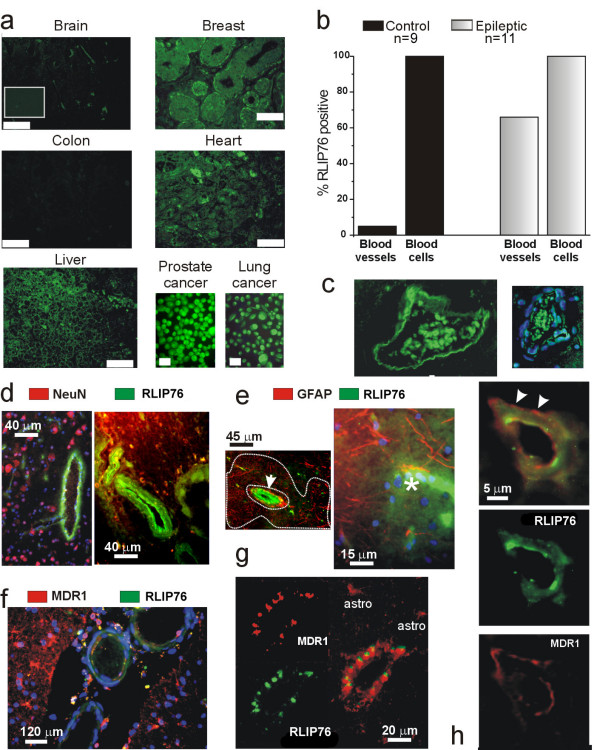Figure 1.

Human expression of RLIP76. A) Immunocytochemical detection was performed on tissue arrays with histological sections from normal human tissue. RLIP76 expression was virtually absent from normal brain autopsies; both gray and white matter were analyzed; cumulative data for brain and blood tissue are presented in b). RLIP76 immunoreactivity was observed in breast lobules of primary duct elements, in cardiac myocytes and liver sinusoids. No expression was found in colon tissue. Intense immunoreactivity was present in cell lines of tumor origin. Bars indicate 60 μm with the exception of the cell culture data, where the bars reflect 10 μm. The inset in a) shows a negative control of a brain section incubated with secondary but not primary antibodies. B) Cerebrovascular expression of RLIP76 in epileptic brain. Blood vessels from multiple drug resistant epileptic brain were characterized by high levels of RLIP76 expression. Both vascular and intravascular cells were RLIP76 immunopositive. RLIP76-positive intravascular cells were anucleated and did not react with the nuclear stain DAPI (in blue, C). Note that erythrocytes were found to be RLIP76 immunopositive in both normal and epileptic tissue. RLIP76 is expressed exclusively in epileptic endothelial cells and does not localize to glia or neurons. D) NeuN expression is segregated from RLIP76 immunoreactivity, which is limited to cortical vessels. E) Widespread GFAP immunoreactivity in epileptic brain does not co-localize with RLIP76 (in green). Both large (arrow) and capillary-size (asterisk) vessels express RLIP76. Note the large region of GFAP positive reactive gliosis (limited by a dotted line) characterized by the absence of RLIP76 expression. F) MDR1 and RLIP76 co-localize in "epileptic" blood vessels but MDR1 expression extends to parenchymal cells. Three large pial vessels are shown to demonstrate the predominant vascular expression of RLIP76. Note that MDR1 expression was more predominant in parenchymal glia. G-H) High power demonstration of endothelial co-expression of RLIP76/MDR1. Note that MDR1 expression co-localized with RLIP76 expressed at the lumenal surface, while MDR1 expression was also observed in RLIP76-negative ablumenal structures reflecting glial endfeet (arrowheads in H). We studied a total of 41 patients, including samples from 6 autopsies. The average age of the patients was 32 ± 18 years, range 3 months – 59 years old. No data are available on the autopsy material, besides the fact that these were adults of either sex. The non-epileptic patients were either undergoing surgery for aneurysm clipping or to remove arteriovenous or other vascular malformations. None of these patients had seizures prior to surgery or received antiepileptic drug treatment. The surgical epileptic patients studied were resistant to the following drugs: CBZ = 61%; PHE = 77%; Pentobarbital = 55%; Tompiramate = 50%; valproic acid = 44%; other AEDs, less than 5%. Most patients were resistant to > two drugs; 1 patients (a 3 months old infant) did not undergo any drug treatment, while another patient (8 month old) attempted ketogenic diet treatment).
